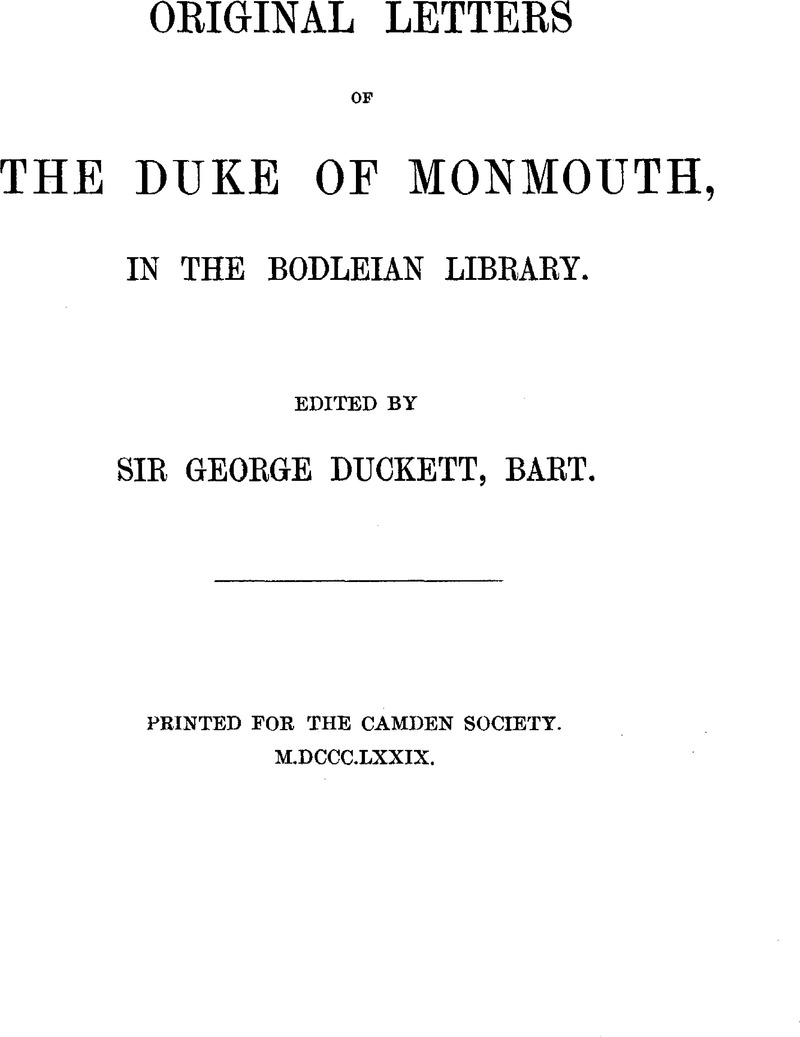No CrossRef data available.
Article contents
Original Letters of the Duke of Monmouth, in the Bodleian Library
Published online by Cambridge University Press: 24 December 2009
Abstract

- Type
- Other
- Information
- Camden New Series , Volume 31: The Camden Miscellany, Volume the Eighth. , December 1883 , pp. 1 - 13
- Copyright
- Copyright © Royal Historical Society 1883
References
page 3 note a Roberts's “Life of Monmouth,” 11, 112, 119; Fox's “History of James II.; ”Ellis's “Historical Letters,” 111.; “Lausdowne MSB.,” 1236, art. 230; Harl. MSS. 7006, 7198.
page 3 note b Rawl. MS. A. 139 b.
page 5 note a Erased in the original; the word being evidently “rebellion.”
page 6 note a Roberts, 11. 135.
page 7 note a Roberts, 11. 114; Clarke's Life of James II.
page 7 note b Dalrymple's Memoirs, Appendix, Part i. 301. The Princess Anne on several occasions expresses her bad opinion of Sunderland. In a letter to her sister the Princess of Orange she says: “You may remember I have once before ventured to tell you that I thought Ld Sunderland a very ill man, and am now more confirmed every day iu that opinion.”
page 8 note a For this last information we are indebted to the recently published Catalogue of the Rawlinson MSS. by the Rev. W. D. Macray.
page 10 note a According to Roberts, a certain “Captain Blood” (whom he calls the “infamous”) was the person intrusted with the letter; but, if this person is intended to be identical with the notorious Colonel Blood, it cannot be correct, for he was not then living, having died in 1680.
page 11 note a Colonel Scott was evidently one of the Bncclengh family.
page 12 note a The identifying history of the Monmouth Letters being, in a great measure, due to Dr. Jebb, a short notice of him may not be out of place. He was decidedly a remarkable man for the age in which he lived, and was probably born somewhere about 1696, for in 1716 we find him a member of Peter-House, Cambridge, being ordained Deacon among the Non-jurors by (Bishop) Jeremy Collier, and Priest in January of the year following, at which time also he published a translation of “Martyn's Answers to Evelyn.” In 1722 he was Editor of the “Bibliotheca Literaria,” and appears at different periods to have been the author of several learned and important works, His name is associated with an Epitaph, written by him in memory of four English gentlemen, who, with their servants, were murdered in 1723, between Haut-Buisson and Marquise, on the road from Boulogne to Calais, but the pyramid on which it was inscribed, marking the site of the murder, has long since vanished, a chapel or oratory having been afterwards erected on the spot. According to Chalmers's Biographical Dictionary, Dr. Jebb was, in 1749, in possession of all Bridges' MSS. relative to the “History of Northamptonshire.” He practised, nearly until his death (in 1772), with great success and reputation as a physician, at Stratford, in Essex, and the works which he commissions Dr. Rawlinson to purchase for him, on medical and chirurgical subjects (in the above letter), have an interest at this day, in respect of a profession, at that time more or less in its infancy. His son, Sir Richard Jebb, followed his father's calling, and was created a Baronet by George III., having been made Physician-Extraordinary to the King in 1777, and employed about the Royal family from that time till his death.




